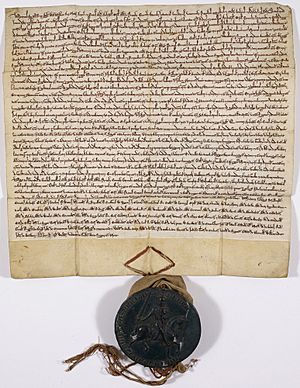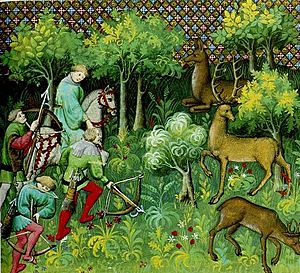Charter of the Forest facts for kids

The Charter of the Forest of 1217 (also known as Carta Foresta) was an important document in England. It gave back rights to ordinary people to use the royal forests. These rights had been taken away by kings like William the Conqueror and his family. Many parts of this Charter were used for hundreds of years.
Young King Henry III first signed the Charter in England. He was helped by William Marshal, 1st Earl of Pembroke, who was looking after the kingdom at the time. The Charter of the Forest was like a partner document to the famous Magna Carta. It fixed some unfair forest laws that earlier kings, like William Rufus, had made too strict.
Contents
The Story Behind the Charter
What Was a "Forest" Back Then?
To the Normans, a "forest" wasn't just a place with lots of trees. It was a special area where the king, or sometimes another powerful person, had the only right to hunt animals. They also controlled the plants and trees where the animals lived. These "forests" included open areas like grasslands and wetlands, not just woods. These lands were important for food, grazing animals, and other resources.
Why the Charter Was Needed
Over time, kings like King Richard and King John made more and more land into royal forests. This meant ordinary people couldn't use these areas. At its biggest, royal forests covered about one-third of southern England. This made life very hard for common people. They struggled to farm, find food, and use the land they lived on.
The Charter of the Forest was first released on November 6, 1217. This happened at St Paul's Cathedral, London. It was a follow-up document to the Magna Carta. The Charter was reissued in 1225 with a few small changes. Later, in 1297, it was officially joined with the Magna Carta in a document called the Confirmation of Charters.
Rights for Ordinary People
Royal forests were super important for people to get fuel for cooking and heating. They also provided materials for industries like making charcoal. People relied on the forests for rights like:
- Pannage: letting their pigs eat acorns and nuts.
- Estover: collecting firewood.
- Agistment: grazing their animals.
- Turbary: cutting turf (like peat) for fuel.
This Charter was special because it gave economic protection to free men. It allowed them to use the forest to find food and graze their animals. Unlike the Magna Carta, which mostly helped powerful barons, the Charter of the Forest gave real rights and protections to common people. It helped them against unfair rules from the rich and powerful.
What the Charter Said
The first part of the Charter protected common pasture in the forest. This meant everyone who used to graze their animals there could keep doing so. Another part said that "every man" could let their animals graze in their own woods within the forest.
The Charter also allowed free men to build things on their own land inside the forest. They could make a mill, a fish pond, or even farm land, as long as it didn't hurt their neighbors. The Charter also reduced the size of the "forest" areas. It made them similar to how they were during King Henry II's time.
Special verderers' courts were created inside the forests. These courts made sure the laws of the Charter were followed.
How the Charter Changed Over Time
By the time of the Tudor kings and queens, most of these laws mainly protected the timber (wood) in royal forests. Some parts of the Forest Laws stayed in effect for a very long time, even until the 1970s!
The special courts mentioned earlier, called Verderers' Courts, still exist today. You can find them in the New Forest and the Forest of Dean. This means the Charter of the Forest was one of the longest-lasting laws in England. It was in force from 1217 until 1971. It was then replaced by a new law called the Wild Creatures and Forest Laws Act 1971.
The Charter was important for showing the value of shared lands and the rights of ordinary people. It stood against the government and the idea of turning all natural resources into private property.
In 2017, to celebrate 800 years of the Charter of the Forest, many groups worked together. The Woodland Trust and over 50 other organizations created a new document. It's called the Charter for Trees, Woods and People. This new Charter shows how people in the UK think about trees and woods today.
Why the Charter Was Important
According to an expert named Guy Standing, the Charter was not just about helping the poor. It was about the rights of all free people. For its time, it was a very strong statement about how important freedom is for everyone.
Where to Find Old Copies
It is believed that only two original copies of the 1217 Charter of the Forest still exist. One is kept at Durham Cathedral and the other at Lincoln Cathedral. The Lincoln copy is usually on display at Lincoln Castle. It is shown alongside Lincoln's copy of the Magna Carta.
A copy of the 1225 reissue of the Charter almost got destroyed in 1865. Luckily, it was saved and is now at the British Library. A recently found copy of the 1300 edition of the Charter of the Forest is in the Sandwich Guildhall Museum in Kent.
See also
- English land law
- Forestry in the United Kingdom
- R v Hampden (1637) 3 Howell State Trials 825, known also as the Case of Shipmony, leading to the Ship Money Act 1640


